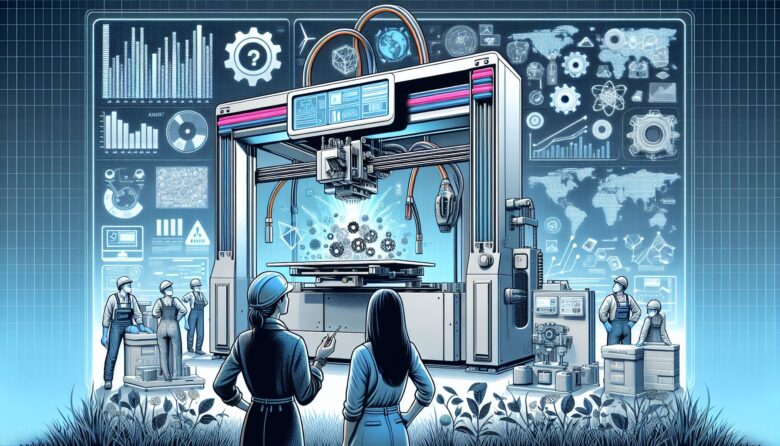
Introduction
In a world driven by technological advancements, one innovation has truly stood out and left its mark on various industries – 3D printing. This cutting-edge technology has revolutionized the way we manufacture and create products, giving birth to endless possibilities and transforming our imagination into reality. In this article, we delve into the world of 3D printing and explore its widespread applications, benefits, and the future it holds.
Body
What is 3D Printing?
At its core, 3D printing, also known as additive manufacturing, is a process of creating three-dimensional objects by depositing materials layer by layer. Unlike traditional subtractive manufacturing methods, where material is removed from a solid piece to obtain the desired shape, 3D printing follows an additive approach. It imparts an innovative approach to manufacturing, allowing complex shapes and designs to be fabricated quickly and efficiently.
How Does 3D Printing Work?
To better understand the wonders of 3D printing, let’s take a closer look at the process. It all starts with a digital model created using computer-aided design (CAD) software or obtained through a 3D scanner. This digital model is then sliced into thin cross-sectional layers, which are interpreted by the 3D printer.
Next, the 3D printer meticulously deposits or melts material, layer by layer, based on the precise dimensions defined by the digital model. This material can vary based on the type of printer and the desired output, ranging from plastics, metals, ceramics, and even biological materials. The layers gradually stack on top of each other until the final product is complete.
Versatility and Applications of 3D Printing
The versatility of 3D printing is one of its most remarkable attributes, enabling a vast array of applications across numerous industries. Let’s explore some of the groundbreaking uses of this innovative technology:
Healthcare and Biomedical Applications
In the field of medicine, 3D printing has paved the way for personalized and patient-specific treatments. Surgeons can create accurate models of organs or bones to better plan and rehearse complex procedures. Additionally, prosthetics and implants can be custom-designed to perfectly fit an individual’s anatomy, significantly improving their quality of life.
Aerospace and Automotive Industries
3D printing has catapulted the aerospace and automotive industries into new frontiers of innovation. By printing lightweight yet robust components, aircraft and automobile manufacturers can improve fuel efficiency, reduce costs, and accelerate prototyping. Complex geometries that were previously impossible to manufacture conventionally can now be effortlessly created, giving engineers and designers unparalleled design freedom.
Architecture and Construction
In the realm of architecture and construction, 3D printing is revolutionizing the way buildings are designed and constructed. Entire structures can be printed layer by layer, significantly reducing construction time and material waste. Additionally, intricate architectural models, showcasing exceptional attention to detail, can be fabricated with ease.
Education and Research
3D printing has also found its way into educational institutions and research laboratories, allowing students and scientists to bring their concepts to life. This technology fosters creativity, enhances learning, and promotes problem-solving skills, as students can transform their ideas into tangible objects right in the classroom. Researchers can also leverage 3D printing to fabricate intricate models and prototypes to support their studies, accelerating the pace of scientific discovery.
Fashion and Design
The fashion and design industry has embraced 3D printing by pushing the boundaries of creativity and enabling the production of unique and complex designs. From avant-garde garments to intricately detailed accessories, this technology offers designers the ability to bring their boldest ideas to fruition. With its growing popularity, 3D printers have become an essential tool for aspiring designers and established fashion houses alike.
Advantages of 3D Printing
The multitude of advantages offered by 3D printing continues to fuel its widespread adoption across various industries. Here are some key benefits that have propelled this technology to the forefront of manufacturing:
Reduced Time and Cost
Compared to traditional manufacturing methods, 3D printing lends itself to faster and cost-efficient production processes. Rapid prototyping allows for quicker iterations, slashing the time required from design to final product. The elimination of costly tooling and molds also represents significant savings for manufacturers.
Customization and Complexity
The ability to create highly customized products tailored to individual needs and specifications is a game-changer made possible by 3D printing. Complex designs with intricate details can be manufactured without additional hassle or cost, providing endless design possibilities previously unimaginable.
Waste Reduction and Sustainability
Traditional manufacturing processes often result in significant material wastage and environmental impact. By employing the additive nature of 3D printing, manufacturers can minimize waste by using only the necessary amounts of materials, reducing their carbon footprint and contributing to a more sustainable future.
Accessibility and Democratization
As the technology continues to evolve, 3D printers are becoming more affordable, compact, and easier to use. This accessibility fosters innovation, empowering entrepreneurs, inventors, and creators to bring their ideas to life without extensive financial investments or complex manufacturing processes. The democratization of manufacturing has the potential to level the playing field and spur a wave of innovation from various sectors of society.
The Future Potential of 3D Printing
With its remarkable capabilities and ever-expanding range of applications, the future of 3D printing appears boundless. As the technology matures, several exciting developments are already being explored and hold promise for the future:
Bioprinting and Organ Transplants
Scientists are actively researching the field of bioprinting, aiming to print functional human organs through the use of specialized biomaterials and cells. This revolutionary advancement in medical technology could alleviate the global shortage of organs for transplantation, saving countless lives.
Space Exploration and Colonization
NASA and other space agencies are investigating the use of 3D printing in space missions. By utilizing available resources such as lunar regolith or Martian soil, astronauts may be able to construct habitats and vital infrastructure on other planets, significantly reducing the cost and logistics associated with space missions.
Food Printing
While it may sound like science fiction, 3D printers capable of producing edible food items are already making headlines. This technology could potentially offer personalized nutrition options, address food scarcity issues, and enable greater control over ingredients and taste.
Spare Parts Manufacturing
The ability to manufacture spare parts on-demand, without the need for costly warehousing or extended lead times, is an area where 3D printing shines. This would alleviate supply chain disruptions and enhance the maintenance and repair capabilities of various industries, from automotive to aerospace.
Conclusion
As we have explored the marvels of 3D printing, it becomes evident that this disruptive technology is reshaping the future of manufacturing and ushering in a new era of innovation. Its versatility, cost-efficiency, and ability to fabricate complex designs have made it indispensable across industries such as healthcare, aerospace, architecture, and more. With ongoing advancements and promising research, the potential of 3D printing knows no bounds, promising exciting developments that will continue to impact society in countless ways. Brace yourself for a future where the possibilities are limited only by our imagination.



